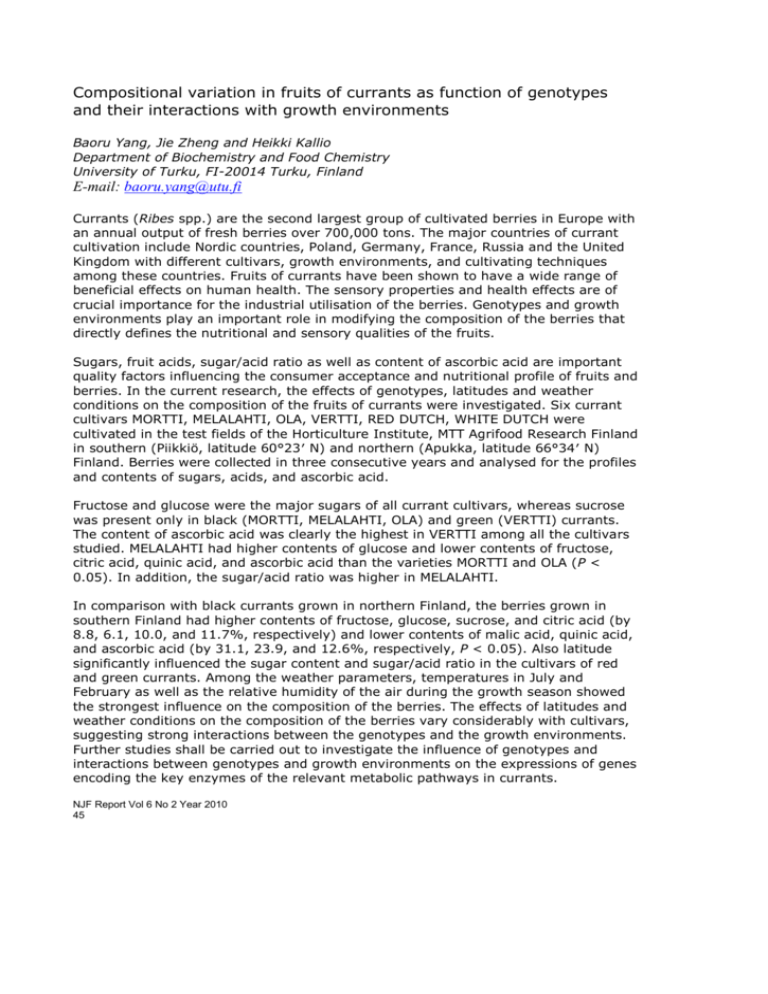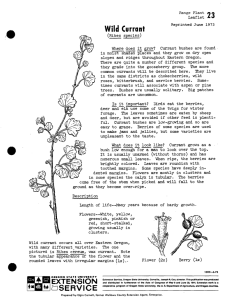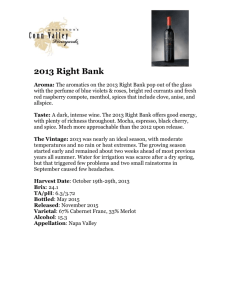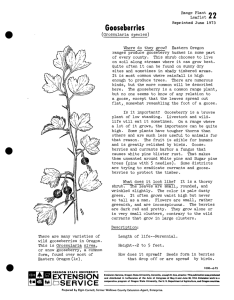Compositional variation in fruits of currants as function of genotypes
advertisement

Compositional variation in fruits of currants as function of genotypes and their interactions with growth environments Baoru Yang, Jie Zheng and Heikki Kallio Department of Biochemistry and Food Chemistry University of Turku, FI-20014 Turku, Finland E-mail: baoru.yang@utu.fi Currants (Ribes spp.) are the second largest group of cultivated berries in Europe with an annual output of fresh berries over 700,000 tons. The major countries of currant cultivation include Nordic countries, Poland, Germany, France, Russia and the United Kingdom with different cultivars, growth environments, and cultivating techniques among these countries. Fruits of currants have been shown to have a wide range of beneficial effects on human health. The sensory properties and health effects are of crucial importance for the industrial utilisation of the berries. Genotypes and growth environments play an important role in modifying the composition of the berries that directly defines the nutritional and sensory qualities of the fruits. Sugars, fruit acids, sugar/acid ratio as well as content of ascorbic acid are important quality factors influencing the consumer acceptance and nutritional profile of fruits and berries. In the current research, the effects of genotypes, latitudes and weather conditions on the composition of the fruits of currants were investigated. Six currant cultivars MORTTI, MELALAHTI, OLA, VERTTI, RED DUTCH, WHITE DUTCH were cultivated in the test fields of the Horticulture Institute, MTT Agrifood Research Finland in southern (Piikkiö, latitude 60°23′ N) and northern (Apukka, latitude 66°34′ N) Finland. Berries were collected in three consecutive years and analysed for the profiles and contents of sugars, acids, and ascorbic acid. Fructose and glucose were the major sugars of all currant cultivars, whereas sucrose was present only in black (MORTTI, MELALAHTI, OLA) and green (VERTTI) currants. The content of ascorbic acid was clearly the highest in VERTTI among all the cultivars studied. MELALAHTI had higher contents of glucose and lower contents of fructose, citric acid, quinic acid, and ascorbic acid than the varieties MORTTI and OLA (P < 0.05). In addition, the sugar/acid ratio was higher in MELALAHTI. In comparison with black currants grown in northern Finland, the berries grown in southern Finland had higher contents of fructose, glucose, sucrose, and citric acid (by 8.8, 6.1, 10.0, and 11.7%, respectively) and lower contents of malic acid, quinic acid, and ascorbic acid (by 31.1, 23.9, and 12.6%, respectively, P < 0.05). Also latitude significantly influenced the sugar content and sugar/acid ratio in the cultivars of red and green currants. Among the weather parameters, temperatures in July and February as well as the relative humidity of the air during the growth season showed the strongest influence on the composition of the berries. The effects of latitudes and weather conditions on the composition of the berries vary considerably with cultivars, suggesting strong interactions between the genotypes and the growth environments. Further studies shall be carried out to investigate the influence of genotypes and interactions between genotypes and growth environments on the expressions of genes encoding the key enzymes of the relevant metabolic pathways in currants. NJF Report Vol 6 No 2 Year 2010 45











